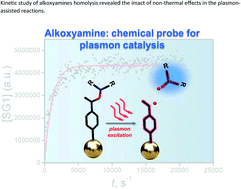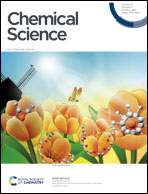Establishing plasmon contribution to chemical reactions: alkoxyamines as a thermal probe†
Abstract
The nature of plasmon interaction with organic molecules is a subject of fierce discussion about thermal and non-thermal effects. Despite the abundance of physical methods for evaluating the plasmonic effects, chemical insight has not been reported yet. In this contribution, we propose a chemical insight into the plasmon effect on reaction kinetics using alkoxyamines as an organic probe through their homolysis, leading to the generation of nitroxide radicals. Alkoxyamines (TEMPO- and SG1-substituted) with well-studied homolysis behavior are covalently attached to spherical Au nanoparticles. We evaluate the kinetic parameters of homolysis of alkoxyamines attached on a plasmon-active surface under heating and irradiation at a wavelength of plasmon resonance. The estimation of kinetic parameters from experiments with different probes (Au–TEMPO, Au–SG1, Au–SG1–TEMPO) allows revealing the apparent differences associated with the non-thermal contribution of plasmon activation. Moreover, our findings underline the dependency of kinetic parameters on the structure of organic molecules, which highlights the necessity to consider the nature of organic transformations and molecular structure in plasmon catalysis.



 Please wait while we load your content...
Please wait while we load your content...